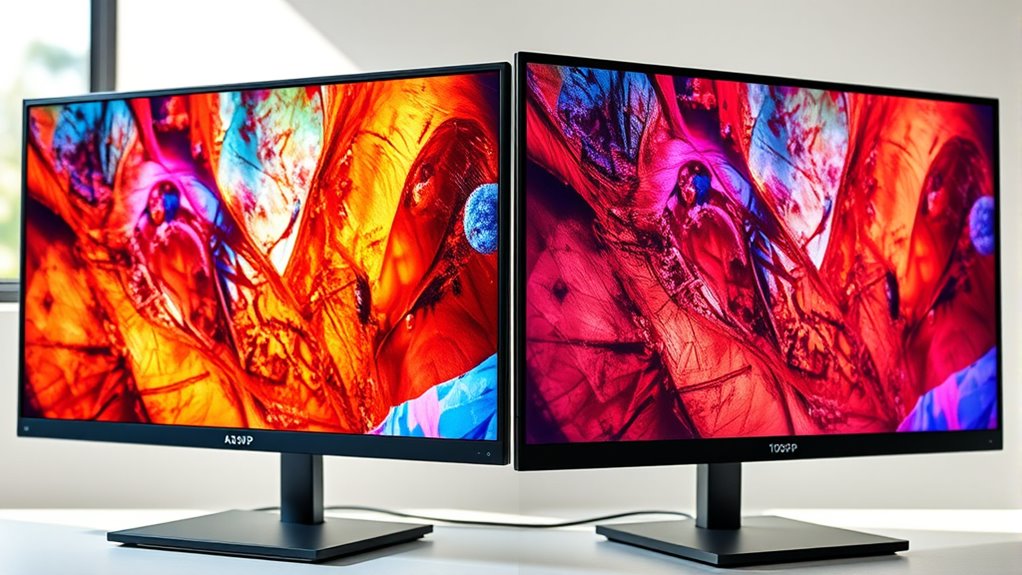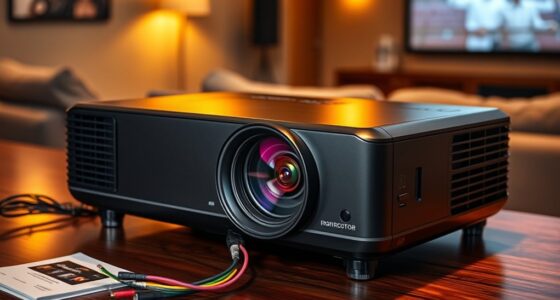Understanding the difference between 4K and 1080p helps you troubleshoot display issues. 4K offers four times the pixels of 1080p, making images sharper but requiring compatible devices and high-quality HDMI cables. If your 4K content appears blurry or is limited to 1080p, it’s likely a compatibility or connection problem. Ensuring your hardware supports the resolution and checking your settings can fix most issues. Keep exploring to learn how to optimize your setup further.
Key Takeaways
- 4K offers four times the pixels of 1080p, resulting in sharper and more detailed images.
- Compatibility issues may cause 4K content to appear blurry or improperly scaled on unsupported devices.
- Use high-speed HDMI cables and verify port versions to support 4K resolution properly.
- Adjust display and device settings manually if automatic resolution negotiation fails.
- Regularly check hardware specifications and update devices to ensure resolution support and optimal display quality.
Understanding Resolution and Compatibility Issues

When choosing between 4K and 1080p displays, understanding their differences can help you troubleshoot issues more effectively. One of the main aspects to consider is resolution differences. 4K displays offer four times the pixels of 1080p screens, resulting in sharper images and more detail. However, if you notice a blurry or pixelated picture on a 4K screen, it might be because your device isn’t properly supporting the higher resolution. Conversely, if a 1080p display appears less sharp on a device that can handle 4K, it could indicate a settings or compatibility issue. Being aware of these resolution differences helps you identify whether the problem stems from the display’s capabilities or the source device. Proper maintenance, including regular cleaning of HDMI ports and filters, can also prevent connectivity issues that affect resolution display. Device compatibility plays a vital role when troubleshooting display issues. Not all devices support 4K resolution, especially older models or budget-friendly options. If your content appears stretched or doesn’t fill the screen properly, it might be because your device isn’t compatible with 4K or isn’t configured to output at that resolution. Similarly, some devices may support 4K but require specific settings adjustments to display properly. For example, you might need to enable HDCP or adjust HDMI port settings. When troubleshooting, double-check your device specifications and verify your hardware supports the resolution you want to use. If compatibility is a problem, you may need to upgrade your device or adjust your settings to optimize performance with what you have. Another aspect to consider is the connection type. For example, HDMI cables and ports have different versions that support varying resolutions and refresh rates. Using an older HDMI cable or port can limit your device to 1080p even if it supports 4K. Upgrading to a high-speed HDMI cable can resolve display issues related to resolution and device compatibility. Also, keep in mind that some devices automatically negotiate the best resolution, but if this process fails, you might need to manually set the resolution in your device’s display settings. Troubleshooting these issues involves verifying that all components—cables, ports, and settings—are compatible and configured correctly. Additionally, understanding resolution support and ensuring your hardware aligns with these requirements can significantly streamline troubleshooting efforts.
Frequently Asked Questions
Can 4K Content Be Played on a 1080P Monitor?
You can play 4K content on a 1080p monitor, but resolution scaling occurs, which means the image gets downscaled to fit your screen. Your monitor’s compatibility limits the display quality, so you won’t see the full 4K detail. While the content will display, it won’t have the sharpness of a true 4K resolution. To get the best quality, use a monitor that supports 4K resolution directly.
How Do I Downgrade 4K Videos to 1080P?
To downgrade 4K videos to 1080p, you need to perform format conversion and video compression. Use free or paid software like HandBrake or Adobe Premiere Pro to resize the video resolution. Import your 4K file, select 1080p as the output resolution, and adjust compression settings to reduce file size without losing much quality. This process guarantees your video plays smoothly on a 1080p display.
Does Higher Resolution Improve Gaming Performance?
Higher resolution doesn’t directly improve gaming performance. In fact, increased resolution impacts gaming performance by demanding more from your GPU, which can lower frame rates. If smooth gameplay is your goal, sticking to 1080p may be better, especially if your hardware isn’t top-tier. Resolution impact varies; higher resolutions look sharper but can strain your system, so consider your GPU’s capabilities before upgrading to 4K for gaming.
Are There Any Health Concerns Using 4K Displays?
Using a 4K display is like walking a tightrope—you should be aware of potential health concerns. You might experience eye strain or discomfort, especially if you spend long hours staring at the screen. Blue light emitted from 4K screens can also disrupt your sleep and cause eye fatigue. To reduce these risks, take regular breaks, use blue light filters, and adjust your display settings for comfortable viewing.
What Are the Best Settings for Troubleshooting Resolution Issues?
To troubleshoot resolution issues, start by adjusting your resolution calibration settings to match your display’s native resolution. Check display scaling options to ensure they’re set correctly, avoiding any distortion or blurriness. Update your graphics driver if problems persist. Experiment with these settings, and restart your device to see if the display improves. Proper resolution calibration and display scaling are key to resolving most resolution problems effectively.
Conclusion
Think of 4K and 1080p as two different canvases—each offering a unique masterpiece. While 4K paints with more detail, it demands a stronger brush and compatibility. By understanding your device’s capabilities, you can choose the perfect resolution that suits your needs. Remember, it’s not about the size of the canvas but the clarity of the picture you want to create. With the right choice, your viewing experience will shine brighter than ever.









